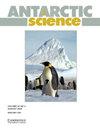Influence of heavy metals on the occurrence of Antarctic soil microalgae
IF 2
4区 地球科学
Q3 ENVIRONMENTAL SCIENCES
引用次数: 2
Abstract
Abstract Human- and animal-impacted sites in Antarctica can be contaminated with heavy metals, as well as areas influenced by underlying geology and naturally occurring minerals. The present study examined the relationship between heavy metal presence and soil microalgal occurrence across a range of human-impacted and undisturbed locations on Signy Island. Microalgae were identified based on cultures that developed after inoculation into an enriched medium. Twenty-nine microalgae representing Cyanobacteria, Bacillariophyta, Chlorophyta and Tribophyta were identified. High levels of As, Ca, Cd, Cu and Zn were detected in Gourlay Peninsula and North Point, both locations hosting dense penguin rookeries. Samples from Berntsen Point, the location of most intense human activity both today and historically, contained high levels of Pb. The contamination factor and pollution load index confirmed that the former locations were polluted by Cd, Cu and Zn, with these being of marine biogenic origin. Variation in the microalgal community was significantly correlated with concentrations of Mn, Ca, Mg, Fe, Zn, Cd, Co, Cr and Cu. However, the overall proportion of the total variation contributed by all metals was low (16.11%). Other factors not measured in this study are likely to underlie the majority of the observed variation in microalgal community composition between sampling locations.重金属对南极土壤微藻发生的影响
摘要南极洲受人类和动物影响的地区可能受到重金属污染,也可能受到潜在地质和天然矿物影响。本研究调查了Signy岛上一系列受人类影响和未受干扰位置的重金属存在与土壤微藻发生之间的关系。微藻是根据接种到富集培养基中后形成的培养物进行鉴定的。鉴定出29种微藻,分别代表蓝藻门、硅藻门、绿藻门和三角藻门。在Gourlay半岛和北角都检测到高水平的As、Ca、Cd、Cu和Zn,这两个地方都有密集的企鹅栖息地。伯恩森角是当今和历史上人类活动最激烈的地方,其样本中铅含量很高。污染因子和污染负荷指数表明,该地区受Cd、Cu和Zn污染,为海洋生物成因。微藻群落的变化与Mn、Ca、Mg、Fe、Zn、Cd、Co、Cr和Cu的浓度显著相关。然而,所有金属在总变化中所占的比例较低(16.11%)。本研究中未测量到的其他因素可能是观察到的采样地点之间微藻群落组成变化的主要原因。
本文章由计算机程序翻译,如有差异,请以英文原文为准。
求助全文
约1分钟内获得全文
求助全文
来源期刊

Antarctic Science
地学-地球科学综合
CiteScore
3.60
自引率
6.20%
发文量
42
审稿时长
3 months
期刊介绍:
Antarctic Science provides a truly international forum for the broad spread of studies that increasingly characterise scientific research in the Antarctic. Whilst emphasising interdisciplinary work, the journal publishes papers from environmental management to biodiversity, from volcanoes to icebergs, and from oceanography to the upper atmosphere. No other journal covers such a wide range of Antarctic scientific studies. The journal attracts papers from all countries currently undertaking Antarctic research. It publishes both review and data papers with no limits on length, two-page short notes on technical developments and recent discoveries, and book reviews. These, together with an editorial discussing broader aspects of science, provide a rich and varied mixture of items to interest researchers in all areas of science. There are no page charges, or charges for colour, to authors publishing in the Journal. One issue each year is normally devoted to a specific theme or papers from a major meeting.
 求助内容:
求助内容: 应助结果提醒方式:
应助结果提醒方式:


